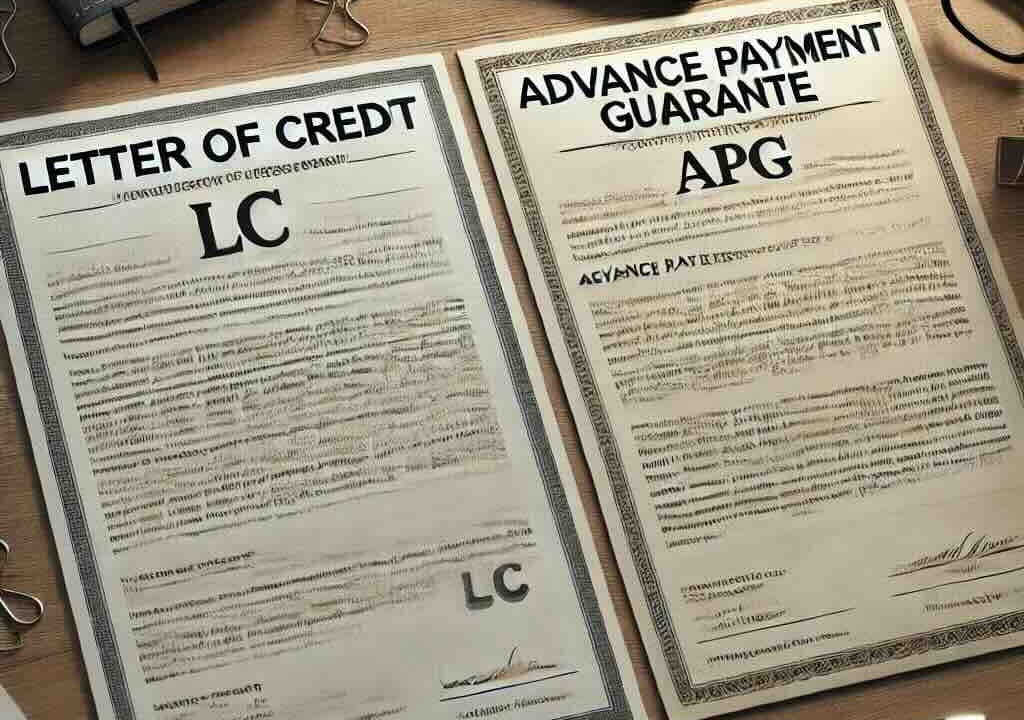Both the Letter of Credit (LC) and the Advance Payment Guarantee (APG) are financial instruments used in international trade and other transactions to ensure trust and security between the buyer and the seller. However, they serve different purposes and operate based on distinct principles. Let’s delve into the differences between the two.
Content….
Purpose
- Letter of Credit (LC): An LC is primarily designed to ensure that payment will be made to the seller provided the terms and conditions stated in the LC have been met. It is a commitment by a bank on behalf of the buyer that payment will be made to the seller, even if the buyer cannot or does not want to make the payment.
- Advance Payment Guarantee (APG): An APG, on the other hand, is a guarantee given by a bank on behalf of a seller (or contractor) that, in the case of non-fulfillment of contractual obligations by the seller after receiving an advance payment, the bank will refund that advance payment to the buyer.
Beneficiary
- LC: The seller or exporter is the beneficiary. They receive payment once they fulfill the stipulated conditions.
- APG: The buyer or importer is the beneficiary. They can claim the advance payment if the seller defaults on their obligations.
Trigger
- LC: The LC is triggered when the seller presents the required documents (like shipping documents, invoice, etc.) that prove they have met the terms and conditions of the LC.
- APG: The APG is triggered when the seller fails to deliver the goods or services as per the agreement after receiving an advance payment.
Issuance
- LC: Issued by the buyer’s bank to the seller’s bank, guaranteeing payment upon presenting specific documents.
- APG: Issued by the seller’s bank to the buyer’s bank, guaranteeing the refund of the advance payment in case of non-fulfillment of the contract by the seller.
Risk Management
- LC: Mitigates the risk for the seller, ensuring that they get paid upon fulfilling their end of the deal.
- APG: Mitigates the risk for the buyer, ensuring they get their advance payment back if the seller defaults.
Associated Cost
- LC: Usually, the buyer bears the cost, but sometimes it’s shared or borne by the seller, depending on the trade agreement.
- APG: Generally, the seller bears the cost since it is a guarantee of their commitment to the contract.
Summary Letter of Credit (LC) and the Advance Payment Guarantee (APG)
While both the LC and APG are designed to enhance trust between the parties involved, they serve different roles. The LC is more about ensuring the seller gets paid once they meet the contract terms, whereas the APG is about securing the buyer’s advance payment against potential default by the seller. Depending on the nature of the transaction and the associated risks, one might be more appropriate than the other.
If you want to learn more about the Tactical buyer role and a standard sourcing process, we recommend “The Sourcing Engine“. The sourcing engine room is build on three courses presenting the basics of a modern sourcing process. Learn about the key activities when preparing, negotiating and implementing a new improved supply chain.
Simplified example of an LC for illustrative purposes
A Letter of Credit (LC) is a more complex instrument than for example an escrow agreement. Its format varies depending on the bank and jurisdiction, but below is a simplified example of an LC for illustrative purposes:

IRREVOCABLE LETTER OF CREDIT
Issuing Bank: [Name of the Issuing Bank, Address, Country]
Date of Issue: [Date]
LC Number: [Unique reference number]
Applicant (Buyer): [Name, Address, and Contact Details]
Beneficiary (Seller): [Name, Address, and Contact Details]
Amount: [Currency and Amount]
Expiry Date: [Date]
Place of Expiry: [Location, typically the beneficiary’s country]
Terms and Conditions:
1. Advising Bank: [Name and Address of the Beneficiary’s Bank]
2. Shipment Details: Goods to be shipped: [Description of Goods], Quantity: [Number or Volume], Shipping from [Port/Location] to [Port/Location].
3. Shipping Date: Latest shipment date is [Date].
4. Documents Required for Payment:
a. Signed commercial invoice in triplicate.
b. Full set of original clean on board ocean bill of lading.
c. Packing list.
d. Certificate of Origin.
e. [Any other documents like inspection certificates, insurance documents, etc.]
5. Payment Terms: We, [Issuing Bank Name], hereby irrevocably undertake to pay the beneficiary the sum not exceeding [Amount] upon presentation and surrender of the documents detailed above, provided the terms and conditions of this LC are fully complied with.
6. Presentation Period: Documents must be presented within [e.g., “21”] days of shipment date but before the expiry of this LC.
7. Partial Shipments: [Allowed/Not Allowed]
8. Transshipment: [Allowed/Not Allowed]
9. Charges: All banking charges outside [Issuing Country] are for the beneficiary’s account. Charges in [Issuing Country] are for the account of the applicant.
10. Governing Law: This Letter of Credit shall be governed by and construed in accordance with the Uniform Customs and Practice for Documentary Credits, ICC Publication No. [e.g., “600”], and to the extent not inconsistent therewith, by the laws of [Issuing Country].
11. Confirmation: [If the LC is to be confirmed by another bank, details of that bank and any relevant terms]
This Letter of Credit is irrevocable and is, under no circumstances, assignable or transferable.
Authorized Signature and Bank Seal
Remember, the above is a basic illustrative example. Real-world LCs may contain additional clauses and stipulations depending on the specific requirements of the transaction. It is always advisable to consult with trade finance experts or legal professionals when working with Letters of Credit.
Learn more about Letter of Credit.
